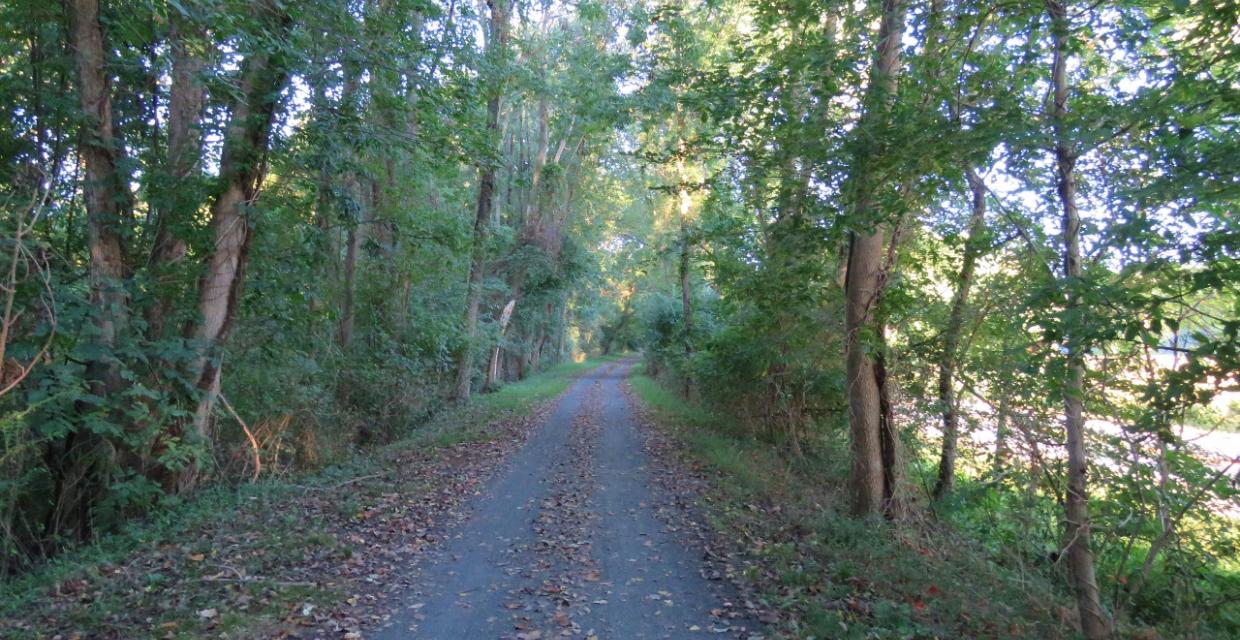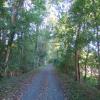Delaware & Raritan Canal State Park [NJ]


Park Overview:
A linear park consisting of 64 miles of flat trail and towpath along an historic canal, with many 19th century structures still standing.
Park Description:
The Delaware and Raritan Canal was built in the early 19th century as an effective means of transportation between Philadelphia and New York, facilitating connections to the rest of world. Once completed, it became one of America's busiest navigational canals. In 1871, its busiest year, total tonnage shipped surpassed the longer and more famous Erie Canal. The canal was abandoned as a route for navigation in the 1920s, but it was preserved virtually intact because it also served as a source of water supply for the neighboring towns (unlike the Morris Canal, which was largely obliterated). Today, with its 19th-century bridges, bridge-tender houses, past and present locks, cobblestone spillways and hand-built stone-arched culverts, the canal is an attraction for history lovers.
The D&R Canal State Park provies a corridor for wildlife to move among forests and preserves in Hunterdon, Mercer, Middlesex, Somerset, and Burlington Counties.
The 24-acre Bull's Island Natural Area is on a small forested island surrounded by the Delaware River and the Delaware & Raritan Canal in Stockton. The lowland floodplain forest is dominated by sycamore, silver maple and tulip poplar and contains several rare plant species. Check its website for details.
Trails Overview:
The park is in the shape of a lazy "V," as the feeder canal parallels the Delaware River [for about 30 miles] and then the main canal extends from Trenton to New Brunswick [for 34 miles]. Unfortunately there is a gap where the canal crosses US 1 outside Trenton.
- The entire length, both main and feeder trails, are ADA accessible. Most of the pathway is surfaced with light gravel; very little is paved, however.
- A four-mile loop hike is possible between Kingston and Rocky Hill by following the towpath in one direction and an abandoned rail bed in the other direction.
- Loop hikes are also possible along the feeder canal by crossing over the Delaware River to Delaware Canal State Park in Pennsylvania.
- Public transportation is available. You can take the NJ Transit Raritan Valley Line to the Bound Brook station, from where the canal (in South Bound Brook) is a half-mile walk. From the NJ Transit Princeton station (take the Northeast Corridor Line to Princeton Junction and transfer to the one-car "dinky" for the ride to Princeton), the canal is about one mile away. The distance from Bound Brook to Princeton is 20 miles, which can be covered in a (long) day, with both ends accessible by train.
- Click for a set of maps, including a mileage table and distance charts. Use the Web Map link on this site for a map of the canal.
Park Acreage:
6595.00 acresMunicipality:
Princeton [main office]A linear park consisting of 64 miles of flat trail and towpath along an historic canal, with many 19th century structures still standing.
The Delaware and Raritan Canal was built in the early 19th century as an effective means of transportation between Philadelphia and New York, facilitating connections to the rest of world. Once completed, it became one of America's busiest navigational canals. In 1871, its busiest year, total tonnage shipped surpassed the longer and more famous Erie Canal. The canal was abandoned...
Park Acreage:
6595.00 acresMunicipality:
Princeton [main office]Contact Information
Web Link:
NJ DEP, Division of Parks and ForestryPhone:
(609) 924-5705Fees:
NoneDogs in park:
Dogs on leashHike Checklist:
Whether you are going for a day hike or backpacking overnight, it is good practice to carry what we call The Hiking Essentials. These essentials will help you enjoy your outing more and will provide basic safety gear if needed. There may also be more essentials, depending on the season and your needs.
The Essentials
Hiking Shoes or Boots
Water - Two quarts per person is recommended in every season. Keep in mind that fluid loss is heightened in winter as well as summer. Don't put yourself in the position of having to end your hike early because you have run out of water.
Map - Know where you are and where you are going. Many of our hiking areas feature interconnecting network of trails. Use a waterproof/tear-resistant Tyvek Trail Conference map if available or enclose your map in a Ziplock plastic bag. If you have a mobile device, download Avenza’s free PDF Maps app and grab some GPS-enhanced Trail Conference maps (a backup Tyvek or paper version of the map is good to have just in case your batteries die or you don't have service). Check out some map-reading basics here.
Food - Snacks/lunch will keep you going as you burn energy walking or climbing. Nuts, seeds, and chocolate are favorites on the trail.
Sunscreen and insect repellent
Rain Gear and Extra Clothing - Rain happens. So does cold. Be prepared for changing weather. Avoid cotton--it traps water against your skin and is slow to dry. If you are wearing wet cotton and must return to your starting point, you risk getting chills that may lead to a dangerous hypothermia. Choose synthetic shirts, sweaters and/or vests and dress in layers for easy on and off.
Compass - A simple compass is all you need to orient you and your map to magnetic north.
Light - A flashlight or small, lightweight headlamp will be welcome gear if you find yourself still on the trail when darkness falls. Check the batteries before you start out and have extras in your pack.
First Aid Kit - Keep it simple, compact, and weatherproof. Know how to use the basic components.
Firestarter and Matches - In an emergency, you may need to keep yourself or someone else warm until help arrives. A firestarter (this could be as simple as leftover birthday candles that are kept inside a waterproof container) and matches (again, make sure to keep them in a waterproof container) could save a life.
Knife or Multi-tool - You may need to cut a piece of moleskin to put over a blister, repair a piece of broken equipment, or solve some other unexpected problem.
Emergency Numbers - Know the emergency numbers for the area you're going to and realize that in many locations--especially mountainous ones, your phone will not get reception.
Common Sense - Pay attention to your environment, your energy, and the condition of your companions. Has the weather turned rainy? Is daylight fading? Did you drink all your water? Did your companion fail to bring rain gear? Are you getting tired? Keep in mind that until you turn around you are (typically) only half-way to completing your hike--you must still get back to where you started from! (Exceptions are loop hikes.)
Check the weather forecast before you head out. Know the rules and regulations of the area.
The Leave No Trace Seven Principles
Plan Ahead and Prepare
- Know the regulations and special concerns for the area you'll visit.
- Prepare for extreme weather, hazards, and emergencies.
- Schedule your trip to avoid times of high use.
- Visit in small groups when possible. Consider splitting larger groups into smaller groups.
- Repackage food to minimize waste.
- Use a map and compass to eliminate the use of marking paint, rock cairns or flagging.
Travel and Camp on Durable Surfaces
- Durable surfaces include established trails and campsites, rock, gravel, dry grasses or snow.
- Protect riparian areas by camping at least 200 feet from lakes and streams.
- Good campsites are found, not made. Altering a site is not necessary.
- In popular areas:
- Concentrate use on existing trails and campsites.
- Walk single file in the middle of the trail, even when wet or muddy.
- Keep campsites small. Focus activity in areas where vegetation is absent.
- In pristine areas:
- Disperse use to prevent the creation of campsites and trails.
- Avoid places where impacts are just beginning.
- Pack it in, pack it out. Inspect your campsite and rest areas for trash or spilled foods. Pack out all trash, leftover food and litter.
- Deposit solid human waste in catholes dug 6 to 8 inches deep, at least 200 feet from water, camp and trails. Cover and disguise the cathole when finished.
- Pack out toilet paper and hygiene products.
- To wash yourself or your dishes, carry water 200 feet away from streams or lakes and use small amounts of biodegradable soap. Scatter strained dishwater.
- Preserve the past: examine, but do not touch cultural or historic structures and artifacts.
- Leave rocks, plants and other natural objects as you find them.
- Avoid introducing or transporting non-native species.
- Do not build structures, furniture, or dig trenches.
- Campfires can cause lasting impacts to the backcountry. Use a lightweight stove for cooking and enjoy a candle lantern for light.
- Where fires are permitted, use established fire rings, fire pans, or mound fires.
- Keep fires small. Only use sticks from the ground that can be broken by hand.
- Burn all wood and coals to ash, put out campfires completely, then scatter cool ashes.
- Observe wildlife from a distance. Do not follow or approach them.
- Never feed animals. Feeding wildlife damages their health, alters natural behaviors, and exposes them to predators and other dangers.
- Protect wildlife and your food by storing rations and trash securely.
- Control pets at all times, or leave them at home.
- Avoid wildlife during sensitive times: mating, nesting, raising young, or winter.
Be Considerate of Other Visitors
- Respect other visitors and protect the quality of their experience.
- Be courteous. Yield to other users on the trail.
- Step to the downhill side of the trail when encountering pack stock.
- Take breaks and camp away from trails and other visitors.
- Let nature's sounds prevail. Avoid loud voices and noises.
The Trail Conference is a 2015 Leave No Trace partner.
(c) Leave No Trace Center for Outdoor Ethics: www.LNT.org.



NJDEP News Release, October 13, 2009
NEW PATHWAY WILL COMPLETE BIKE LOOP FROM FRENCHTOWN TO NEW BRUNSWICK
09/P23)TRENTON - Department
of Environmental Protection Acting Commissioner Mark N. Mauriello today
announced construction will begin on pathway that will complete the 70-mile
trail running along the Delaware & Raritan
Canal from Frenchtown to New Brunswick
“This unique public-private partnership will open an area previously inaccessible to outdoor enthusiasts,” Commissioner Mauriello said. “This final stretch will allow cyclists, joggers and walkers to enjoy a scenic route throughTrenton
The easement along theD&R Canal